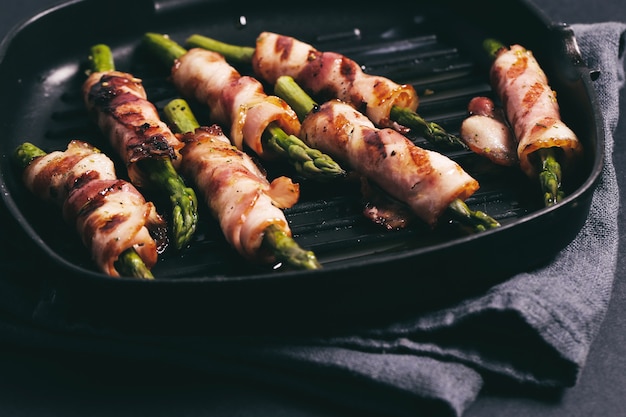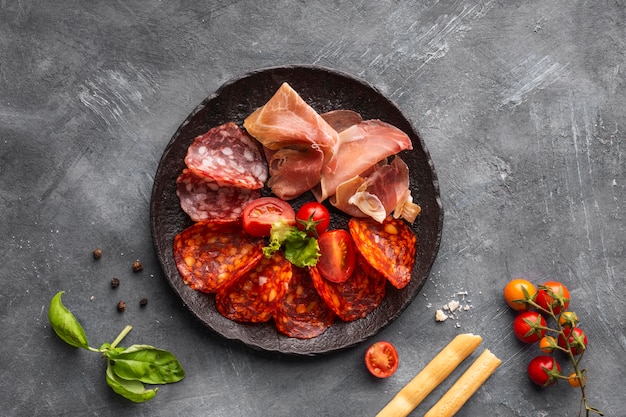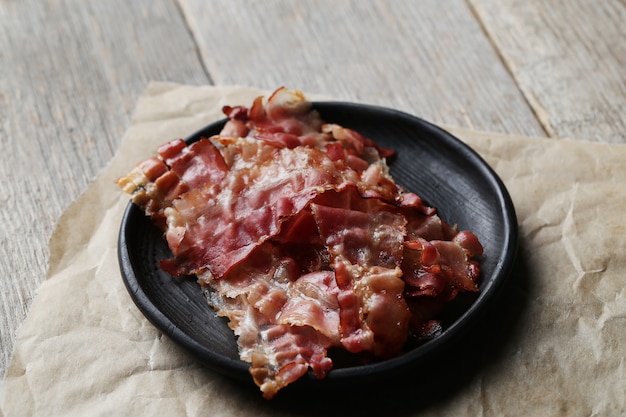Ah, bacon. Just the word conjures images of sizzling fat, a heavenly aroma, and that irresistible crunch. But achieving that perfect crispy bacon isn't always a sure thing. I've been on a quest for the ultimate crispy bacon for years, experimenting with different methods, types of bacon, and pans. And let me tell you, it's a journey worth taking. So, grab a cuppa, settle in, and let me share my secrets for achieving bacon nirvana.
(Part 1) The Bacon: The Foundation of Greatness

You can't expect greatness without the right foundation, and for perfect bacon, that foundation is the bacon itself. It's not just about grabbing any old pack from the supermarket, folks. Trust me, I've learned the hard way. So, let's delve into the world of bacon types and how to choose the best for your crispy masterpiece.
The Bacon Basics: Types and Styles
The world of bacon can be surprisingly diverse. You've got your classic british bacon, your leaner back bacon, and even a whole host of flavored varieties. But for the perfect crispy bacon, we'll focus on two main types:
- streaky bacon: This is the classic British bacon, made from the belly of the pig. It's known for its marbling – those beautiful streaks of fat that render into a rich, savory pool as it cooks. This marbling is what gives it that melt-in-your-mouth texture and deep, satisfying flavour. If you're looking for that classic bacon experience, streaky is the way to go.
- Back Bacon: This comes from the loin of the pig, making it leaner than streaky bacon. It often has a firmer texture and is usually smoked, adding another layer of flavor complexity. Back bacon holds up well in dishes where you want a strong, meaty flavour and a bit more bite.
And then there's the thickness. thick-cut bacon is my personal favourite. It's got a more substantial feel and can handle higher heat, ensuring those beautiful, crispy edges. Thin-cut bacon can be a little trickier to cook evenly and may burn before it gets crispy. However, it does cook faster, so it's a good option if you're short on time.
The Importance of Quality: What to Look for
So, you've got your type and thickness sorted, but there's still the question of quality. Think of it like this: You wouldn't expect a Michelin-star chef to use the cheapest ingredients, would you? The same goes for your bacon. Look for bacon from reputable brands known for their high-quality meat. It's a little pricier, but the difference in flavour and texture is truly noticeable. Trust me, you'll thank yourself for the investment.
Another tip: Pay attention to the ingredients. Look for bacon with minimal added sugar and nitrates. You want to taste the pure, unadulterated flavour of the bacon, not a bunch of artificial stuff. It's not just about taste; it's about being mindful of what we're consuming.
(Part 2) The Pan: Choosing the Right Tool for the Job

Now, you've got your bacon, but you need the right pan to cook it in. Just like choosing your bacon, you need to pick the right pan for the job. This is where your culinary journey really takes off.
The Cast Iron King: A Classic for a Reason
cast iron skillets are my go-to for crispy bacon. They're a true culinary heirloom, passed down through generations and cherished for their exceptional heat retention and even cooking. Cast iron sears bacon beautifully, giving it a gorgeous, caramelized exterior, and the seasoned surface prevents it from sticking. And let's be honest, there's just something magical about the way bacon cooks in a cast iron skillet – it adds a depth of flavour that's hard to replicate.
Other Pan Options: Exploring the Alternatives
Don't have a cast iron skillet? Don't fret! Other types of pans can still deliver excellent results. Here's a rundown of some good alternatives:
- Stainless Steel Skillet: A high-quality stainless steel skillet is a workhorse in any kitchen. Just ensure it has a heavy bottom to distribute heat evenly. It might take a bit longer to heat up than cast iron, but it'll get the job done.
- Non-Stick Skillet: A non-stick skillet is great for less mess and easier cleaning. However, be cautious of high heat, as the non-stick coating can degrade over time. Keep the temperature moderate and you'll be fine.
Important Tip: Size Matters
Whether you choose cast iron, stainless steel, or non-stick, make sure your pan is large enough to accommodate your bacon without overcrowding. Overcrowding leads to uneven cooking and soggy bacon, and we don't want that! Give your bacon the space it needs to reach its full crispy potential.
(Part 3) The Heat: Finding the Perfect Temperature

You've got the bacon, you've got the pan – now it's time to talk about the heat. This is where it gets a bit tricky. Getting the temperature just right is essential for achieving that perfect balance of crisp and tenderness. It's a delicate dance between too hot (burning) and too low (limp bacon), and you need to be the conductor.
The Golden Rule: Medium-High Heat
My general rule of thumb is to start with medium-high heat. This allows the bacon to render its fat quickly and develop that beautiful crispy exterior. On a gas stove, I aim for about 375°F (190°C). If you're using an electric stove, it might take a little longer to reach that ideal temperature. Be patient!
The Visual Clue: When the Fat Starts to Sizzle
You'll know you've got the heat right when the bacon fat starts to sizzle, and you see a hint of smoke rising from the pan. Don't worry, that's a good sign! It means your pan is hot enough to render the fat and give you that perfect crisp.
Adjusting the Heat: A Matter of Observation
As the bacon cooks, you might need to adjust the heat slightly. If it's browning too quickly, turn it down a notch. If it's taking too long to crisp up, give it a little more heat. Just keep an eye on it and adjust as needed. You're the chef, remember?
(Part 4) The Technique: Mastering the Art of bacon cooking
We've got the ingredients, we've got the equipment, now it's time for the magic – the technique. This is where your bacon-cooking skills truly shine. Here are some simple but crucial tips that can elevate your bacon game.
The Single-Layer Secret: No Overcrowding Allowed
I've said it before, and I'll say it again: Overcrowding is a cardinal sin of bacon cooking! Think of it like a crowded dance floor – nobody can move freely, and you end up with a sticky, uncomfortable mess. Cook your bacon in a single layer, giving each strip ample space to sizzle, render fat, and achieve that perfect crisp.
Flipping Frenzy: The Importance of Rotation
Don't just leave your bacon to its own devices. It needs your attention! Flip it regularly to ensure it cooks evenly on both sides. I usually flip my bacon every 2-3 minutes, depending on the heat of the pan. It's a quick, simple maneuver, but it makes a world of difference in the final result.
The Patience Game: Don't Rush the Process
This is a big one. Resist the urge to rush the process. Bacon needs time to cook properly and achieve that perfect crisp. It's like a good wine – it needs to mature and develop its full flavour potential. Patience is a virtue, and it's especially important when it comes to bacon.
(Part 5) The Fat: A Culinary Treasure
Okay, let's talk about the bacon fat. It's not just a greasy byproduct of the cooking process. It's a culinary treasure, a liquid gold that can elevate your cooking to new heights.
Saving the Treasure: Don't Waste It!
As the bacon cooks, you'll see the pan filling with golden-coloured fat. Don't pour it down the drain! That's like throwing away a precious ingredient. Carefully pour it into a heat-proof container, and store it in the fridge. You'll thank yourself later.
Cooking with Bacon Fat: A World of Flavor
Bacon fat is a magical ingredient. It adds a rich, savoury depth to just about anything you cook. Use it to fry eggs, sauté vegetables, roast potatoes – the possibilities are endless. It's even fantastic for making popcorn or baking cookies. Seriously, it's like a culinary superpower.
The Fat Removal Trick: Achieving Perfect Crisp
While we're on the topic of bacon fat, there's one little trick I like to use for that extra-crispy finish. When the bacon is almost done, pour off about half of the rendered fat. This allows the remaining bacon to crisp up quickly and evenly without being submerged in a pool of fat. It's a simple step, but it really makes a difference.
(Part 6) The Finish: Knowing When It's Done
So, how do you know when your bacon is cooked to perfection? There are a few telltale signs to look for. You need to be a seasoned bacon connoisseur, using all your senses to determine the moment of perfection.
The Visual Cue: Golden Brown and Crisp
The bacon should be a beautiful golden brown color, almost translucent at the edges. It'll have a slightly curled shape, indicating that it's rendered its fat and reached its peak of crispiness.
The Texture Test: Firm and Not Soggy
Give the bacon a little press with your spatula. It should be firm and springy, not soft and soggy. You'll feel that satisfying crunch under your spatula, indicating that it's cooked through and achieved that perfect texture.
The Smell Test: That Heavenly Aroma
Let's be honest, your nose will tell you when it's done. That heavenly aroma of crispy bacon will fill your kitchen, enticing your senses and letting you know it's time to dig in. Trust your senses, my friend, and follow that aroma!
(Part 7) The Presentation: Serving Up Your Crispy Creation
You've cooked your bacon to perfection, now it's time to present it. Let's make it look as good as it tastes. A well-presented bacon is a joy to behold.
Paper Towels: The Secret to Crunchy Perfection
Once your bacon is cooked, transfer it to a plate lined with paper towels. This will absorb any excess fat and help to keep the bacon nice and crispy. A little pat with a paper towel is all it takes to ensure that perfect, satisfying crunch.
The Cooling Factor: Maintaining Crispness
Let the bacon cool slightly on the paper towels before serving. This will help to firm up the texture and prevent it from becoming soggy. Patience is key here, as you want that beautiful, crisp texture to last.
Creative Presentation: Beyond the Plate
While there's nothing wrong with a simple plate of crispy bacon, feel free to get creative with your presentation. You can serve it on a bed of lettuce, sprinkle it on top of a salad, or even use it as a garnish for other dishes. The possibilities are endless!
(Part 8) Beyond the Skillet: Exploring Other bacon cooking methods
While skillet cooking is my go-to method, there are other ways to achieve that perfect crispy bacon. Explore these methods and see which one suits your culinary style best.
The oven method: Batch Cooking for Busy Days
If you're cooking for a crowd or just want to make a big batch of bacon, the oven is a great option. Preheat your oven to 400°F (200°C) and line a baking sheet with parchment paper. Place your bacon strips on the baking sheet, leaving a little space between them. Cook for about 15-20 minutes, flipping the bacon halfway through, until it's crispy. It's a simple, hands-off method that's perfect for those busy days.
The Air Fryer: A Quick and Easy Solution
The air fryer is a fantastic tool for cooking crispy bacon quickly and easily. Simply line your air fryer basket with parchment paper, place your bacon strips in a single layer, and cook for about 5-7 minutes at 400°F (200°C). No flipping required! It's a great option for smaller batches or when you're looking for a faster cooking time.
The Microwave: Not Your Best Option (But Still Possible)
I'm not going to lie, microwaving bacon is not my favorite method. You're not going to get that crispy, caramelized texture. However, if you're in a pinch, it's an option. Simply place your bacon on a microwave-safe plate lined with paper towels and cook for about 1-2 minutes, checking it regularly. It's not the most ideal way to cook bacon, but it gets the job done in a pinch.
FAQs: Answering Your Bacon Burning Questions
1. Can I cook bacon on a lower heat?
You can, but it will take longer and you may not get that same level of crispness. If you're using a lower heat, you'll need to cook the bacon for a longer period of time and flip it more frequently. Be patient and persistent, and you might achieve a decent result.
2. How do I prevent bacon from curling up too much?
This is a common problem, especially with thicker bacon. One trick is to partially cook the bacon on one side before flipping it. This helps to prevent it from curling too much. You can also try trimming the fat off the bacon before cooking, which helps to create a more even shape. It's a little extra effort, but it can make a big difference in presentation.
3. What can I do if my bacon is too salty?
Unfortunately, there's not much you can do about it once it's cooked. If you find your bacon is too salty, try soaking it in cold water for a few minutes to reduce the saltiness. You can also try adding a little sugar to the pan while cooking, which helps to balance out the saltiness. It's a bit of a last-minute fix, but it can help.
4. Can I freeze cooked bacon?
Absolutely! You can freeze cooked bacon for up to 2 months. Simply place the bacon in a freezer-safe bag and squeeze out as much air as possible. To reheat, you can either bake it in the oven or microwave it on a plate lined with paper towels. It's a great way to save time and have perfectly cooked bacon on hand when you need it.
5. What are some other things I can do with bacon fat?
The possibilities are endless! Use it to fry eggs, sauté vegetables, roast potatoes, make popcorn, bake cookies, or even create your own bacon-flavored seasoning. Let your culinary creativity run wild! It's a versatile ingredient that can add a delicious depth of flavour to a wide range of dishes.
So there you have it, my friends. A comprehensive guide to achieving the perfect crispy bacon in a skillet. It's all about the details, from choosing the right bacon to mastering the technique. It's a journey of discovery, experimentation, and deliciousness. So go forth, experiment, and enjoy the crispy, salty, satisfying world of perfectly cooked bacon!
Everyone is watching

Corn on the Cob: The Ultimate Guide to Perfectly Cooked Ears
Healthy MealsAh, corn on the cob. Just the name evokes images of sunny days, barbecues, and that sweet, juicy flavour that ...

Perfect Pork Roast Oven Cooking Time: A Guide to Delicious Results
Healthy MealsThere's something truly satisfying about a perfectly roasted pork. The aroma alone is enough to make your mout...

Ham Cooking Time: How Long to Bake, Smoke, or Boil a Delicious Ham
Healthy MealsAh, ham. It's a classic, isn't it? A real crowd-pleaser, especially around holidays. And when done right, it'...

Scallops: The Ultimate Guide to Perfect Cooking
Healthy MealsAh, scallops. Those delicate, sweet, and utterly delicious morsels of the sea. They hold a special place in my...

Spaghetti Squash: The Ultimate Guide to Cooking and Serving
Healthy MealsRemember that time you saw spaghetti squash at the supermarket, looking all bumpy and strange, and thought, "W...
